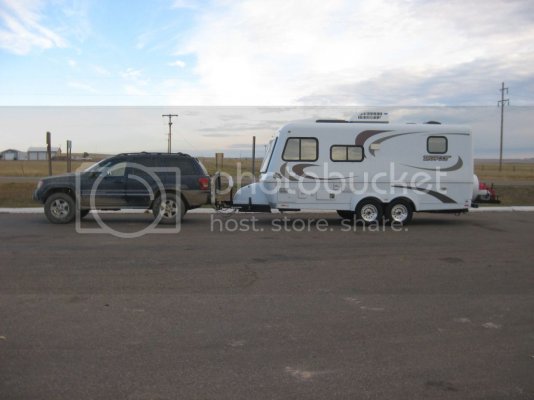Rader
Senior Member
- Joined
- Dec 29, 2016
- Posts
- 109
- Reaction score
- 88
- Location
- In the Montana Rocky Mountains
- Ram Year
- 2015
- Engine
- 3.0 Diesel
Like anything else experience is a major factor in what we feel comfortable with. I have a 21 ft TT that has a GVWR of 7,500 and the it is equipped for remote camping when loaded it is right up there. The hitch weight is considerable, it has an Onan 2500 LP generator & propane tank on the tongue and two group 31 AGM batteries just behind the generator. It has two mounted plumbed in 7.5 propane tanks in the rear and a rack that I carry another propane tank and seven 5 gallon gas and or diesel cans.
I have a Ram 2500 diesel that I occasionally towed it with but because many of my trips were to hunt or fish when I reached my destination I preferred to tow it with the lifted WJ overland on BFG MTs that I owned at that time. The WJ Overland had the factory tow package, wired for the brake controller and at all times I used an Equal-i-zer brand weight distribution hitch. I didn't keep track of miles but my guess is I towed the TT about 20,000 miles back and forth across the US and all over the west. No control problems and not one mechanical problem other than the 4.7 grunting on hills and a few flat tires.
The WJ is gone, In 2015 I bought a 1500 EcoDiesel, even though I still have the Ram 2500 diesel the 1500 rides better and gets better mileage so it is my preferred tow rig at this time. I noted a few mentions of feeling uncomfortable towing in crosswinds, the best advise I could give is no matter what you are towing with slow down in crosswinds and if you are towing in areas know for blowing over travel trailers and trailer trucks like for instance on I-90 Livingston MT take the alternate route when the signs for dangerous cross winds are out. Crosswinds are not a danger to your truck or even Jeep if you have a good sway controlling hitch, the danger is your trailer may end up on its side, that even happens to trailer trucks.

I have a Ram 2500 diesel that I occasionally towed it with but because many of my trips were to hunt or fish when I reached my destination I preferred to tow it with the lifted WJ overland on BFG MTs that I owned at that time. The WJ Overland had the factory tow package, wired for the brake controller and at all times I used an Equal-i-zer brand weight distribution hitch. I didn't keep track of miles but my guess is I towed the TT about 20,000 miles back and forth across the US and all over the west. No control problems and not one mechanical problem other than the 4.7 grunting on hills and a few flat tires.
The WJ is gone, In 2015 I bought a 1500 EcoDiesel, even though I still have the Ram 2500 diesel the 1500 rides better and gets better mileage so it is my preferred tow rig at this time. I noted a few mentions of feeling uncomfortable towing in crosswinds, the best advise I could give is no matter what you are towing with slow down in crosswinds and if you are towing in areas know for blowing over travel trailers and trailer trucks like for instance on I-90 Livingston MT take the alternate route when the signs for dangerous cross winds are out. Crosswinds are not a danger to your truck or even Jeep if you have a good sway controlling hitch, the danger is your trailer may end up on its side, that even happens to trailer trucks.

Last edited:

